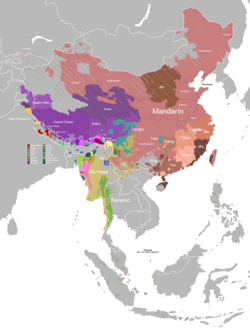Magar Voices
Unveiling the Structure and Heritage of a Sino-Tibetan Tongue.
Discover Magar 👇 Explore Sounds 🔊Dive in with Flashcard Learning!
🎮 Play the Wiki2Web Clarity Challenge Game🎮
Introduction
Linguistic Identity
Magar Dhut, known in Nepali as मगर धुत (magar dhut), is a Sino-Tibetan language.[1] It is primarily spoken by the Magar people, for whom the language is an essential component of their cultural identity.[4]
Geographic Reach
The language is predominantly spoken in Nepal, with significant communities also found in southern Bhutan, and across various regions of India, including Sikkim, Assam, and the Darjeeling district.
Geographical Distribution
Western Magar
The Western Magar dialects, including Palpa and Syangja, are spoken across several districts in Nepal:
- Lumbini Province: Palpa District
- Gandaki Province: Syangja District, and parts of Tanahun District (west of the Bagmati River)
- Gandaki Province: Parbat District (small border area)
- Karnali Province: Scattered communities, particularly in Surkhet, Jajarkot, and Dailekh Districts.
Eastern Magar
Eastern Magar, with dialects such as Gorkha, Nawalparasi, and Tanahu, is found in these regions of Nepal:
- Central Mountains (East of Bagmati River): Tanahun District and southern Gorkha District (Gandaki Province); Palpa, Kapilvastu, and Nawalparasi Districts (Lumbini Province); Dhading District (Bagmati Province).
- Eastern Nepal: Sindhuli District (Bagmati Province); Okhaldhunga, Udayapur, Dhankuta, Bhojpur, and Ilam Districts (Koshi Province); Jhapa District (Koshi Province).
- Bhutan: Southern regions.
Presence in India
In India, Magar communities and language speakers are found in:
- Sikkim: Magar is an additional official language.
- West Bengal: Darjeeling and Kalimpong districts.
- Assam: Golaghat, Sonitpur, and Tinsukia districts.
- Manipur: Certain areas.
Phonology
Consonants
Magar exhibits a rich consonant system, including stops with varying degrees of voicing and aspiration, fricatives, nasals, laterals, and approximants. Some sounds are dialect-specific.
Vowels and Diphthongs
Magar possesses a distinct vowel system, featuring monophthongs and a variety of diphthongs, contributing to its unique phonetic landscape.
Writing Systems
Script Diversity
The Magar language utilizes multiple writing systems, reflecting its historical and contemporary contexts:
- Akkha Script: This is the officially recognized script for the Magar language.
- Devanagari: Widely used in Nepal, it is also employed for writing Magar.
- Latin Script: Adopted for transliteration and modern communication.
Note: The IPA phonetic symbols used throughout this page require proper rendering support for accurate display.
Language Classification
Sino-Tibetan Family Tree
Magar belongs to the Sino-Tibetan language family, a vast macrofamily encompassing languages across Asia. Its specific placement within this family is detailed below:
Official Status
Recognition and Curricula
In Nepal, the constitution provides for the development of Magar language curricula. However, challenges persist in ensuring these materials reach Magar schools, where instruction often defaults to the Nepali language.[4]
In India, Magar holds the status of an additional official language in the state of Sikkim.
Teacher's Corner
Edit and Print this course in the Wiki2Web Teacher Studio

Click here to open the "Magar Language" Wiki2Web Studio curriculum kit
Use the free Wiki2web Studio to generate printable flashcards, worksheets, exams, and export your materials as a web page or an interactive game.
True or False?
Test Your Knowledge!
Gamer's Corner
Are you ready for the Wiki2Web Clarity Challenge?

Unlock the mystery image and prove your knowledge by earning trophies. This simple game is addictively fun and is a great way to learn!
Play now
References
References
Feedback & Support
To report an issue with this page, or to find out ways to support the mission, please click here.
Disclaimer
Important Notice
This page was generated by an Artificial Intelligence and is intended for informational and educational purposes only. The content is based on a snapshot of publicly available data from Wikipedia and may not be entirely accurate, complete, or up-to-date.
This is not linguistic advice. The information provided on this website is not a substitute for professional linguistic consultation, analysis, or study. Always refer to official linguistic resources and consult with qualified linguists for specific academic or research needs. Never disregard professional advice because of something you have read on this website.
The creators of this page are not responsible for any errors or omissions, or for any actions taken based on the information provided herein.
